
Home - Search - Browse - Alphabetic Index: 0- 1- 2- 3- 4- 5- 6- 7- 8- 9
A- B- C- D- E- F- G- H- I- J- K- L- M- N- O- P- Q- R- S- T- U- V- W- X- Y- Z
STS-2
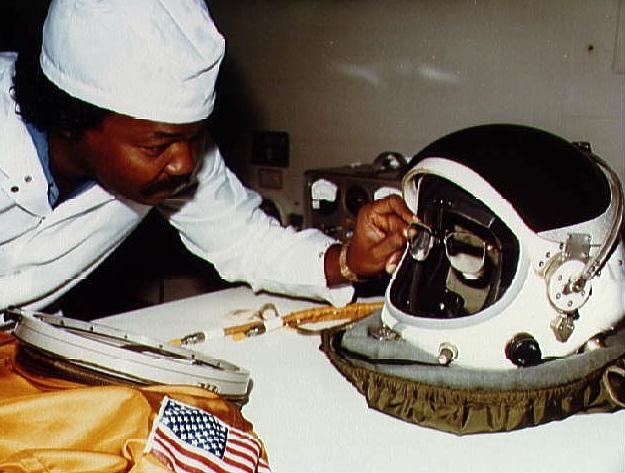
STS-2
STS-2 suit preparation
Credit: NASA
AKA: Columbia;OSTA-1. Launched: 1981-11-12. Returned: 1981-11-14. Number crew: 2 . Duration: 2.26 days.
Payloads: Office of Space and Terrestrial Applications (OSTA)-1 experiments, Orbiter Experiments (OEX). Orbits of Earth: 36. Distance traveled: 1,729,347 km. Orbiter Liftoff Mass: 104,647 kg. Orbiter Mass at Landing: 92,650 kg. Payload to Orbit: 8,517 kg. Payload Returned: 8,517 kg. Landed at: Runway 23 dry lake bed at Edwards Air Force Base, . Landing Speed: 365 kph. Touchdown miss distance: 237 m. Landing Rollout: 2,350 m.
NASA Official Mission Narrative
Mission Name: STS-2 (2)
COLUMBIA (2)
Pad 39-A (14)
2nd Shuttle mission
2nd Flight OV-102
1st Flight of RMS
Shortened mission
Crew:
Joseph H. Engle (1), Commander
Richard H. Truly (1), Pilot Backup
Crew:
Thomas K. Mattingly (1), Commander
Henry W. Hartsfield (0), Jr., Pilot
Milestones:
04/29/81 - Move to OPF-1
08/10/81 - Move to VAB-3
08/31/81 - Move to PAD-39A (21 days)
11/12/81 - Launch
11/14/81 - Landing
11/25/81 - Return to KSC (11 days)
Payload:
OFT(MAPS,SIR-A,SMIRR,FILE,OCE),OSTA-A,DFI(2),ACIP(2),IECM
Mission Objectives:
Demonstrate safe re-launch and safe return of the orbiter and crew. Verify the combined performance of the entire shuttle vehicle - orbiter, solid rocket boosters and external tank.
Payloads included the Orbital Flight Test Pallet consisting of the Measurement of Air Pollution from Satellite (MAPS) experiment, the Shuttle Multispectral Infrared Radiometer (SMIRR) experiment, the Shuttle Imaging Radar (SIR-A) experiment, the Features Identification and Location Experiment (FILE) and the Ocean Color Experimetn (OCE). Also included was the 11,048 lb Development Flight Instrumentation (DFI) pallet, the Aerodynamic Coefficient Identification Package (ACIP), the Induced Environment Contamination Monitor (IECM) and the 5,395 lb Office of Space and Terrestrial Applications Pallet (OSTA-1).
Launch:
November 12, 1981, 10:09:59 a.m. EST. Launch on Oct. 9 was rescheduled when nitrogen tetroxide spill occurred during loading of forward reaction control system (RCS). Launch Nov. 4 delayed and then scrubbed when countdown computer called for hold in countdown due to apparent low reading on fuel cell oxygen tank pressures. During hold, high oil pressures discovered in two of three auxiliary power units (APUs) that operate hydraulic system. APU gear boxes flushed and filters replaced, forcing launch reschedule Launch Nov. 12 delayed two hours, 40 minutes to replace multiplexer/demultiplexer and additional nine minutes, 59 seconds to review systems status. Modifications to launch platform to overcome solid rocket booster overpressure problem were effective.
Modifications of the water sound suppression system at the pad to absorb the solid rocket booster overpressure wave during launch were effective -- no tiles were lost and only 12 were damaged. Launch Weight: 320,708 lbs
Orbit:
Altitude: 157nm
Inclination: 38.0 degrees
Orbits: 37
Duration: Two days, Six hours, 13 minutes, 12 seconds
Distance: 1,074,757 miles
Hardware:
SRB: BI-002
SRM: 002SW(SPM)
ET : 3/SWT-2
MLP: 1
SSME-1: SN-2007
SSME-2: SN-2006
SSME-3: SN-2005
Landing:
November 14, 1981, 1:23:11 p.m. PST, Runway 23, Edwards Air Force Base, Calif. Rollout distance: 7,711 feet. Rollout time: 50 seconds. Mission shortened by approximately three days due to number one fuel cell failure. Orbiter returned to KSC Nov. 25,1981. Landing Weight: 204,262 lbs.
Mission Highlights:
Planned five day mission cut nearly three days due to failure of one of three fuel cells that produce electricity and drinking water, but 90 percent of mission objectives achieved, including first time remote manipulator system tests. Mission scientists satisfied with data from Office of Space and Terrestrial Applications-1 (OSTA-1) Earth observation experiments mounted on Spacelab pallet in payload bay.
The flight marked the first time a manned space vehicle had been reflown with a second crew: Joseph H. Engle, commander, and Richard H. Truly, pilot. It again carried the DFI package, as well as the OSTA-l payload -- named for the NASA Office of Space and Terrestrial Applications -- which consisted of a number of remote sensing instruments mounted on a Spacelab pallet in the payload bay. These instruments, including the Shuttle Imaging Radar-A (SIR-1), successfully carried out remote sensing of Earth resources, environmental quality, ocean and weather conditions. In addition, the Canadian-built Remote Manipulator System (RMS) arm was successfully operated in all its various operating modes for the first time.
More at: STS-2.
Family: Manned spaceflight. People: Engle, Truly. Country: USA. Spacecraft: Columbia. Projects: STS. Launch Sites: Cape Canaveral. Agency: NASA, NASA Houston.
 | STS-2 Credit: www.spacefacts.de |
 | STS-2 Space shuttle Columbia being lowered down toward the solid rocket boosters Credit: NASA |
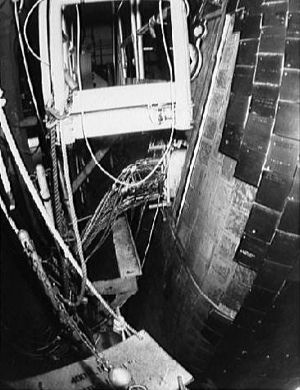 | STS-2 Tile repair activities at Pad 39A after Nitrogen Tetroxide Spill Credit: NASA |
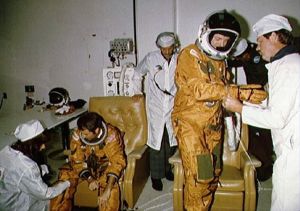 | STS-2 View of the STS-2 prime crew during Countdown demonstration test (CDDT) Credit: NASA |
 | STS-2 Space Shuttle Columbia OV (101) launching from pad 39A beginning STS-2 Credit: NASA |
 | STS-2 Aerial views of the STS-2 launch from Pad 39A at Kennedy Space Center Credit: NASA |
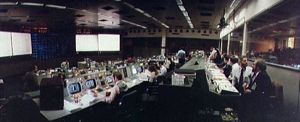 | STS-2 Wide angle view of overall activity in Mission Operations Control Room Credit: NASA |
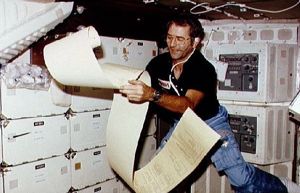 | STS-2 Pilot Truly reviews TAGS teleprinter printout of instructions on middeck Credit: NASA |
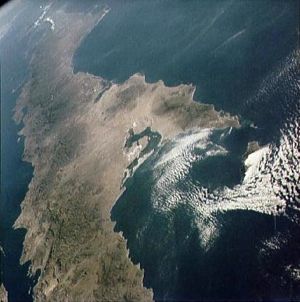 | STS-2 Baja California, Mexico Credit: NASA |
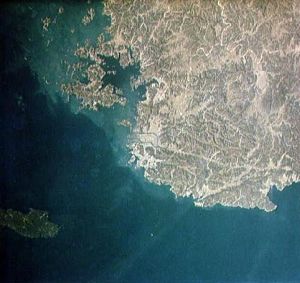 | STS-2 Earth observation photo of Pusan, South Korea Credit: NASA |
 | STS-2 Astronauts Truly and Engle engaged in on-board activity Credit: NASA |
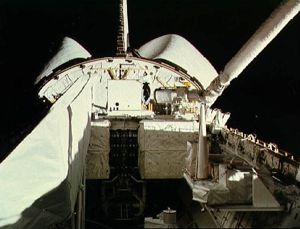 | STS-2 View of the Columbia's open payload bay and the Canadian RMS Credit: NASA |
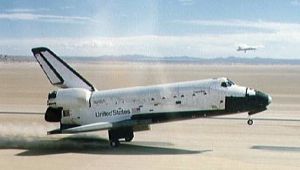 | STS-2 Views of STS-2 Columbia landing at Edwards Air Force Base, California Credit: NASA |
1981 November 12 - . 15:10 GMT - . Launch Site: Cape Canaveral. Launch Complex: Cape Canaveral LC39A. Launch Platform: MLP1. LV Family: Shuttle. Launch Vehicle: Space Shuttle.
- STS-2 - . Call Sign: Columbia. Crew: Engle, Truly. Payload: Columbia F02 / DFI. Mass: 8,517 kg (18,776 lb). Nation: USA. Related Persons: Engle, Truly. Agency: NASA Houston. Program: STS. Class: Manned. Type: Manned spaceplane. Flight: STS-2. Spacecraft Bus: Shuttle. Spacecraft: Columbia. Duration: 2.26 days. Decay Date: 1981-11-14 . USAF Sat Cat: 12953 . COSPAR: 1981-111A. Apogee: 231 km (143 mi). Perigee: 222 km (137 mi). Inclination: 38.00 deg. Period: 89.00 min. Second shuttle test flight. Payloads: Office of Space and Terrestrial Applications (OSTA)-1 experiments, Orbiter Experiments (OEX)..
1981 November 13 - .
- STS-2 - Wakeup Song: Pigs in Space - . Flight: STS-2. "Pigs in Space" comedy routine #1 by The Muppets..
1981 November 14 - .
- STS-2 - Wakeup Song: Pigs in Space - . Flight: STS-2. "Pigs in Space" comedy routine #2 by The Muppets, preceded by rendition of"Columbia, Gem of the Ocean" by the Flight Operations Directorate group"Contraband" .
1981 November 14 - .
- Landing of STS-2 - . Return Crew: Engle, Truly. Nation: USA. Related Persons: Engle, Truly. Program: STS. Flight: STS-2. STS-2 landed at 21:23 GMT. .
Back to top of page
Home - Search - Browse - Alphabetic Index: 0- 1- 2- 3- 4- 5- 6- 7- 8- 9
A- B- C- D- E- F- G- H- I- J- K- L- M- N- O- P- Q- R- S- T- U- V- W- X- Y- Z
© 1997-2019 Mark Wade - Contact
© / Conditions for Use